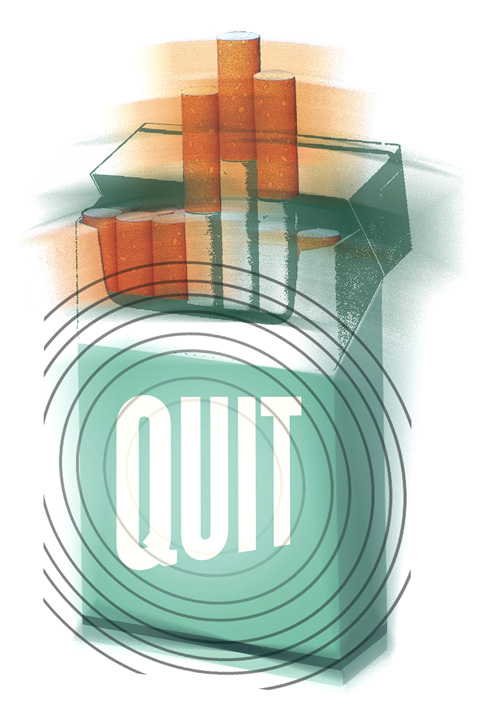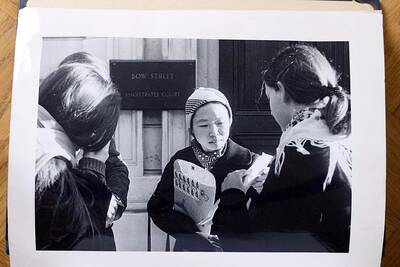Michael Shaw, a 40-year-old from Brooklyn who has smoked cigarettes for 24 years, says he really wants to quit. And I do not doubt his sincerity. He has tried to give up cigarettes many times. But after several days or weeks of not smoking, something happens — an evening out with friends, an emotional upset or just plain boredom — and he relapses.
His sole weapon so far in battling his addiction, he says, has been willpower. But what scores of experts on nicotine addiction have come to learn is that willpower is rarely enough. Most diehard smokers need methods far stronger — and usually a combination of stop-smoking aids — to help quit in the first place and, more important, remain former smokers.
There are exceptions. I was amazed when my husband, who had smoked for 50 years, quit cold turkey in 1994 after one session with a hypnotist and a few sticks of nicotine gum.

ILLUSTRATION: NY TIMES NEWS SERVICE
Survey statistics from the US Centers for Disease Control and Prevention show that 70 percent of smokers say they want to quit and that 40 percent try to quit each year. But 80 percent of smokers who try to quit on their own relapse within a month, the data show, and only 3 percent remain former smokers at six months.
Though long called a lifestyle choice or pernicious habit, smoking is now widely recognized as an addictive disease comparable to alcoholism or heroin addiction.
“Tobacco addiction is best considered a chronic disease, with most smokers requiring repeated interventions over time before achieving permanent abstinence,” Neal L. Benowitz of the University of California, San Francisco, said last month in The American Journal of Medicine.
BIOLOGICAL BASIS OF ADDICTION
Like other addicting substances, nicotine produces pleasurable effects that prompt smokers to keep up the habit and, ultimately, lose control over smoking, often even when dire consequences like a heart attack, cancer or emphysema result.
Among the addiction-maintaining effects of nicotine are arousal, relaxation, improved mood, reduced anxiety and stress, better concentration and faster reaction time. When deprived, smokers report withdrawal symptoms that include irritability, depression, restlessness, anxiety, difficulty concentrating, increased hunger, insomnia, a craving for tobacco, difficulty getting along with others and a feeling that life lacks pleasure.
These effects have a biological basis. Nicotine easily crosses the blood-brain barrier, where it binds to nicotine-specific receptors in the brain. This results in the release of a host of neurotransmitters, primarily dopamine, that “signals a pleasurable experience and is critical to the reinforcing effects of nicotine and other drugs of abuse,” Benowitz explained.
Repeated exposure to nicotine increases the receptors and induces tolerance to and dependence on nicotine. Smokers typically take in the amount of nicotine needed to bind to the receptors. When the drug is withdrawn, in a night’s sleep, for example, or in an effort to quit, the falloff in nicotine rewards becomes a barrier to lasting abstinence.
Changes also occur in brain function as measured on an electroencephalogram, especially in the so-called reward center of the brain.
In addition to the biological effects of nicotine, conditioned behaviors reinforce its continued use. Smokers quickly learn to associate nicotine intake with certain moods, situations or environmental circumstances, both pleasant and unpleasant. As Shaw of Brooklyn has found, those circumstances become powerful cues for the urge to smoke.
Benowitz also noted that other aspects of smoking like lighting up, manipulating the cigarette, the taste or smell of smoke and the feel of smoke in the throat also become linked to the pleasurable effects of smoking.
SOURCES FOR TREATMENT
Since smoking addiction involves physiological, behavioral and psychological factors, all three need to be addressed, often repeatedly, to help smokers quit for good.
As Stephen I. Rennard of the University of Nebraska Medical Center in Omaha wrote in the journal, addressing fellow clinicians, “It is no longer adequate simply to recommend smoking cessation.”
As with other chronic diseases like diabetes and heart disease, Rennard said, both pharmacological and behavioral therapy are needed to control it. He added that because smoking is often a relapsing disorder, clinicians “must be prepared to readdress the problem of smoking on a regular basis and to re-treat patients who backslide.”
Many products on the market can reduce or eliminate the symptoms of nicotine withdrawal, which so often lead to failed attempts to quit. Nicotine replacement therapy is regarded as safe, even in high doses and even for heart patients, and it carries none of the risks of smoking, which exposes people to higher levels of nicotine and 4,000 toxins. Products are available as skin patches, gums, lozenges, inhalers and nasal spray.
Individuals can choose whichever method is most comfortable and convenient, as well as using a combination of a short-acting product like nicotine gum or nasal spray with a longer-acting one like the nicotine patch. According to Michael B. Steinberg of the University of Medicine and Dentistry of New Jersey in New Brunswick, nicotine replacement can be safely used for as long as a former smoker finds it necessary.
Lack of insurance coverage is a major barrier to effective use of nicotine replacements. Writing in The Annals of Internal Medicine in April, Steinberg and colleagues urged that the cost be covered by medical insurance, especially because it would be much cheaper than treating a smoking-induced disease. They noted that “tobacco dependence kills more people than many classic medical diseases” and far more than any other forms of addiction.
Two other drugs approved for treating smokers who want to quit are a sustained-release form of the antidepressant bupropion (which helps reduce cravings among former smokers and, unlike most antidepressants, does not cause weight gain or sexual dysfunction), and a relatively new drug, varenicline. It is the first non-nicotine product created specifically to enhance smoking cessation by partly filling up nicotine receptors to prevent the reinforcing effects of smoking.
To help would-be quitters resist emotional and behavioral cues to smoke, there are individual and group counseling programs, as well as smoking cessation phone lines, Web sites and chat rooms and state-financed support services.
Smoking cessation experts at the Mayo Clinic recommend these Web sites: www.becomeanex.org and www.quitnet.com.
In addition, some would-be quitters like my husband have been helped by hypnosis or acupuncture, though well-thought-out studies have yet to validate these methods fully, Benowitz said in an interview.
Remember, too, that even if you fail to quit once, twice or even three or more times, try again. There are more tools available than ever to assure the success of everyone who wants to become a former smoker.

From the last quarter of 2001, research shows that real housing prices nearly tripled (before a 2012 law to enforce housing price registration, researchers tracked a few large real estate firms to estimate housing price behavior). Incomes have not kept pace, though this has not yet led to defaults. Instead, an increasing chunk of household income goes to mortgage payments. This suggests that even if incomes grow, the mortgage squeeze will still make voters feel like their paychecks won’t stretch to cover expenses. The housing price rises in the last two decades are now driving higher rents. The rental market

Fifty-five years ago, a .25-caliber Beretta fired in the revolving door of New York’s Plaza Hotel set Taiwan on an unexpected path to democracy. As Chinese military incursions intensify today, a new documentary, When the Spring Rain Falls (春雨424), revisits that 1970 assassination attempt on then-vice premier Chiang Ching-kuo (蔣經國). Director Sylvia Feng (馮賢賢) raises the question Taiwan faces under existential threat: “How do we safeguard our fragile democracy and precious freedom?” ASSASSINATION After its retreat to Taiwan in 1949, the Chinese Nationalist Party (KMT) regime under Chiang Kai-shek (蔣介石) imposed a ruthless military rule, crushing democratic aspirations and kidnapping dissidents from

July 28 to Aug. 3 Former president Chiang Kai-shek (蔣介石) reportedly maintained a simple diet and preferred to drink warm water — but one indulgence he enjoyed was a banned drink: Coca-Cola. Although a Coca-Cola plant was built in Taiwan in 1957, It was only allowed to sell to the US military and other American agencies. However, Chiang’s aides recall procuring the soft drink at US military exchange stores, and there’s also records of the Presidential Office ordering in bulk from Hong Kong. By the 1960s, it wasn’t difficult for those with means or connections to obtain Coca-Cola from the

It looks like a restaurant — but it’s food for the mind. Kaohsiung’s Pier-2 Art Center is currently hosting Comic Bento (漫畫便當店), an immersive and quirky exhibition that spotlights Taiwanese comic and animation artists. The entire show is designed like a playful bento shop, where books, plushies and installations are laid out like food offerings — with a much deeper cultural bite. Visitors first enter what looks like a self-service restaurant. Comics, toys and merchandise are displayed buffet-style in trays typically used for lunch servings. Posters on the walls present each comic as a nutritional label for the stories and an ingredient